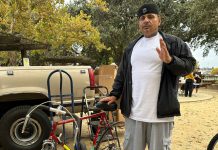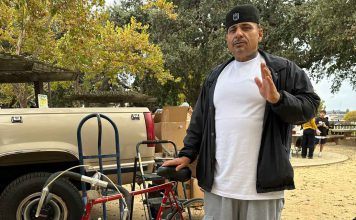High school student volunteers who work at the polls learn a
different way
Gilroy – Taking a day off school to volunteer as a poll worker is not a chance for kids to skip classes and make an extra buck, according to most school and county officials, but critics say high-schoolers learn more in classrooms, not as volunteers.
The Santa Clara County Registrar of Voters has run the High School Election Officer Program since 1997 to recruit student volunteers for polling places throughout the county.
Staffing these sites can be difficult depending on the election cycle, said SCCRV officials who partially rely on student volunteers to adequately staff the hundreds of polling places throughout the county.
College-bound students earn community service hours and experience a taste of the political process by rising at 6am to work a 16-hour day setting up voting machines and helping residents cast their ballots.
Plus, students who participate in the Santa Clara County Registrar of Voters’ High School Election Officer Program earn $125 if they work a full day, $77.50 if they work a half day with 2pm as the shift change.
“The money would be nice,” said Robert Gallion, a 16-year-old junior at Gilroy High School. “You ask anyone to do that, and they’ll be interested.”
Not every interested student can volunteer, though, since they must be a U.S. citizen, at least 16 years old and with a grade point average of 2.5 or greater. Then they have to secure permission from their school and legal guardian before taking a five-hour training course from the SCCRV.
GHS Student Activities Director Julie Berggren heads this year’s effort at the high school.
She favors the program and said the 10 students who have volunteered so far all have 3.0 GPAs or greater and are not looking for a lucrative day off from school: There is too much preparation and training involved, and they have to make up any school work they miss.
While the school loses about $40 per day in state funding for each absent student, the relatively few student volunteers this year won’t cause a significant dent in the school’s pocketbook.
“A lot of the kids like [volunteering] because they get a chance to see how voting works from a different perspective,” Berggren said.
While this may be true, GUSD trustee Denise Apuzzo sees the program as premature. She said she volunteered at polls when she was younger, and so did her mother, but that they were both more than 18 years old.
“While it’s a great civic duty, I think it really needs to be done with kids who are out of high school and already graduated,” Apuzzo said. “In college, you’re not missing as much work because your schedule is more flexible, but for high school students, it’s really important for them to be in school each day.”
Apuzzo has a daughter who is a freshman at GHS and a son who is an eligible 16-year-old sophomore.
“When my son is 18 and graduated, I would encourage him to do that,” Apuzzo said.
GUSD trustee Javier Aguirre said students learn both inside and outside the classroom, and since elections only take place once or twice a year, there is little room for student mischief or abuse of the program.
“Being engaged in their community offers students the opportunity to see how the electoral process works, and it promotes civic engagement,” Aguirre said. “Plus, knowing that there are these parameters for a student’s GPA, make-up work and school and parent approval, I think it’s a great opportunity.”
SCCRV spokeswoman Elma Rosas agreed and said the program is also a valuable bridge between generations.
“In most instances, the long-term, experienced workers enjoy the students because it’s a great inter-generational experience,” Rosas said, “and the students are usually very tech-savvy and energetic.”
Students are just part of the poll worker pool that the SCCRV tries to recruit, Rosas said.
Despite the “drastic” increase in absentee voters – the number has gone from about 9,000 people in 2002 to more than 300,000 this year, out of the county’s 680,000 registered voters – SCCRV spokesman Matt Moreles said state law still requires the county to provide polling sites based on the number of voters, not on the number of voters who are not registered absentee.
But since more people are indeed voting by mail, poll workers have “more time and less lines,” Moreles said.
“Election officers at polls have more time to help people out now,” Moreles said, “so that alleviates some of the crunch there.”
Still, some absentee voters decide to drop off their ballots at polling places the day of the elections instead of mailing them in. And then there is the ebb and flow of voter turnout that each site must react to.
Whatever the issue, Moreles and Rosas said that the SCCRV ensures there are enough polling places and enough workers, and students are an important ingredient.
“Even though we’ve seen that absentee vote increase dramatically, we still make every effort to staff our polling places adequately,” Rosas said, adding that general and gubernatorial elections require more workers than smaller, off-season elections such as primaries.
Despite their importance to the voting process, many students seem not to know about the volunteering opportunity or do not care.
“I’m not too interested in doing that,” said Brandon Schwartz, a 17-year-old senior at GHS. “$125 sounds good, but I don’t want to spend all that time training for it.”
Still, Moreles said the SCCRV actively works with individual schools throughout the county to encourage volunteering, though some are not as cooperative as GHS and Berggren have been, he said.
GHS students have until Thursday to volunteer, said Berggren, who added that past volunteers have returned to her anything but rested.
“Most students say it was very interesting,” Berggren said, “and that it was just a really long day.”
Chris Bone covers City Hall for The Dispatch. Reach him at 847-7109 or cb***@************ch.com.














